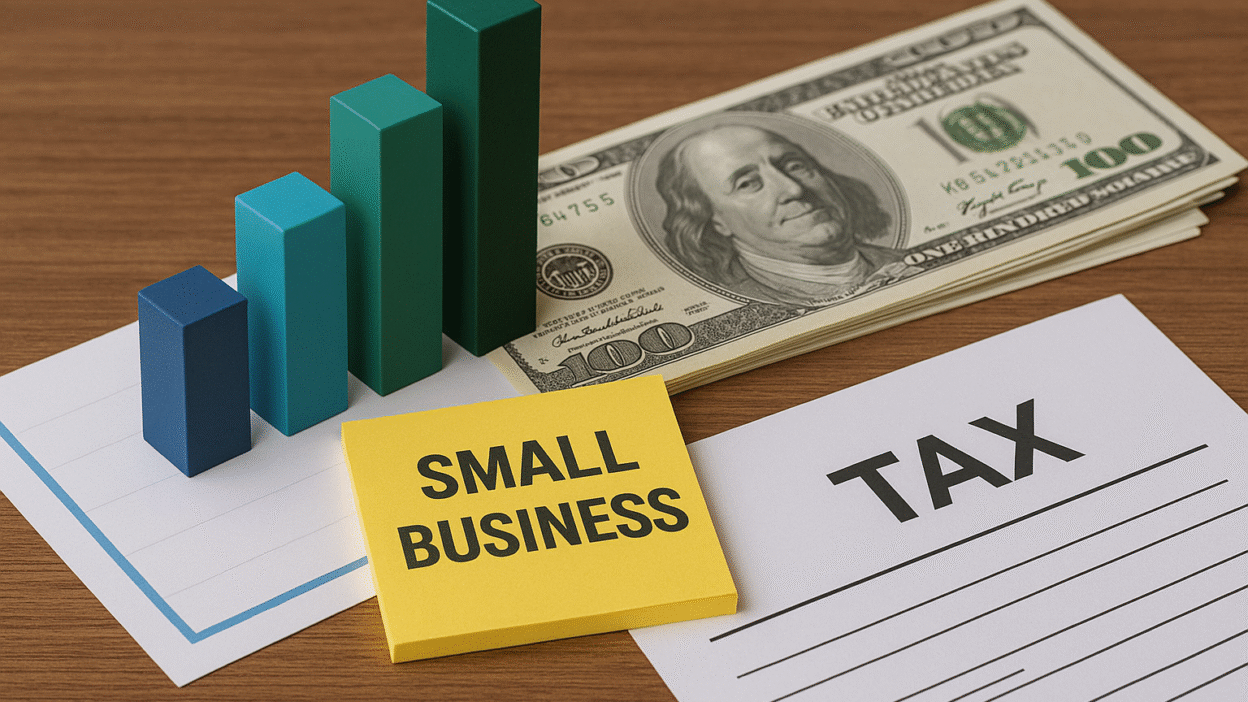Are high taxes eating into your small business’s profits? You’re not alone—many entrepreneurs feel overwhelmed by the complexity of tax law and miss out on legal strategies to lower taxes on a small business legally. In this guide, you’ll learn how to strategically structure your company, leverage deductions and credits, and harness the power of retirement contributions to reduce taxable income.
We’ll walk you through choosing the optimal business structure (think S-Corp or LLC), timing income and expenses, maximizing Section 179 deductions, and benefiting from lesser-known options like QSBS and Qualified Opportunity Zones. Along the way, we’ll highlight real-life examples, expert advice, and little-used strategies—like employing family members or investing in energy-efficient upgrades. By the end, you’ll have a clear, actionable roadmap to optimize your small business’s tax position—not by skirting the law, but by understanding it.
Ready to keep more of your revenue and grow more confidently? Let’s dive into the legal ways to minimize your small business tax burden.
Choose the Right Entity for Tax Savings
Sole Proprietorship vs LLC vs S-Corp
Your business structure determines how you’re taxed. A sole proprietorship is simple but exposes you to full self-employment tax. An LLC gives some liability protection, but unless taxed as an S-Corp, it’s still subject to self-employment tax.
An S-Corp allows you to pay yourself a “reasonable salary” and take the rest as distributions, which are not subject to self-employment tax. This structure can save thousands in taxes yearly, especially for businesses earning $60,000+ annually.
How S-Corp Status Reduces Taxes
If your net income is $100,000 and you pay yourself a $50,000 salary, you pay payroll taxes on the $50,000 only. The rest can be taken as distributions, reducing your tax burden significantly.
Cash vs Accrual Accounting Strategies
Income Deferral to Next Year
Cash-basis businesses can delay sending invoices or hold off on deposits until January to defer income.
Timing Expenses to Maximize Write-Offs
You can prepay expenses like rent, subscriptions, or utilities before December 31 to reduce your current year’s taxable income.
Master the Qualified Business Income (QBI) Deduction
Eligibility & Limitations
QBI allows eligible businesses to deduct up to 20% of qualified income. It applies to pass-through entities: sole props, LLCs, partnerships, S-Corps.
Real-Life Examples
If your LLC earns $100,000 in qualified income, you could deduct $20,000 from taxable income—legally.
Leverage Retirement Plans for You and Your Team
Solo 401(k), SEP IRA, Keogh Plans
You can contribute up to $66,000 (2023) to a Solo 401(k). Contributions reduce taxable income.
Employee Contributions: Dual Benefit
Offering 401(k)s to staff reduces business taxes and boosts retention.
Maximize Section 179 & Depreciation
Equipment, Vehicles, Software
Section 179 allows you to deduct the full purchase price of qualifying business assets in the year of purchase.
Bonus Depreciation vs MACRS
Bonus depreciation lets you deduct 100% of qualified property; MACRS spreads deductions over several years.
Deduct Everyday Business Expenses
Home Office & Vehicle Use
A home office deduction can be based on square footage. Vehicle deductions can be standard mileage or actual expenses.
Legal, Insurance, Professional Fees
Keep receipts for all professional services—they’re deductible.
Employee Benefits & Hiring Family
Health Insurance Deduction
Deduct health insurance premiums for you and eligible dependents if you’re self-employed.
Employing Spouse/Children
Paying children under 18 can be exempt from FICA. Their income is taxed at lower rates, reducing overall family taxes.
Tap into Tax Credits: R&D, Energy, ERC
Research & Development Credit
Covers expenses for developing new products/processes.
Energy Efficiency & Green Incentives
Businesses investing in solar, EV charging stations, or energy upgrades can qualify for deductions and credits.
Employee Retention Credit Aftermath
You may still file amended returns if you qualified for the ERC in previous years.
Advanced Tax Planning Strategies
QSBS & Section 1202
Qualified Small Business Stock (QSBS) held 5+ years can be sold tax-free (up to $10M or 10x basis).
Qualified Opportunity Zones (QOZ)
Investing capital gains in QOZ funds delays tax and may exclude gains entirely after 10 years.
Cost Segregation for Real Estate
Real estate owners can accelerate depreciation by classifying parts of buildings separately.
Track Deductions Year-Round
Bookkeeping Practices & Software
Use tools like QuickBooks or Bench to organize finances and receipts.
Create an Annual Tax Calendar
Note quarterly due dates, equipment purchases, retirement deadlines, etc.
Plan for Estimated and Payroll Taxes
Quarterly Estimates
Pay taxes in four quarterly installments to avoid penalties.
Avoiding Penalties and Interest
Ensure payroll taxes are timely. Late payments incur steep IRS penalties.
What to Do at Year-End
Accelerate Expenses vs Defer Income
Make big purchases or contributions before year-end to reduce taxable income.
Reevaluate Entity & Benefit Contributions
Year-end is ideal for deciding whether to change entities or max out contributions.
Avoiding Trouble: Compliance & IRS Audits
Proper Documentation
Keep bank statements, receipts, contracts, and mileage logs for at least 3 years.
Section 183 Hobby Loss Rule
Businesses must show a profit motive. Otherwise, IRS may deny deductions.
Unique Insights from Tax Experts
S-Corp Compensation Strategies
IRS scrutinizes “reasonable salary”. Balance salary and distributions strategically.
Retirement Funding with Spouse on Payroll
Hiring your spouse boosts contribution limits and allows for spousal IRA plans.
Conclusion
Lowering your small business tax bill legally isn’t about finding loopholes—it’s about understanding your options. By choosing the right entity, utilizing QBI, taking full advantage of Section 179, tapping into credits like R&D or energy incentives, and planning year-round, you can keep more money in your business. Combine solid bookkeeping with strategic advice, and tax season becomes an opportunity—not a burden.
Work with a qualified tax advisor to customize these strategies for your business. A few small tweaks could save you thousands.
Quick Takeaways
- Choose an S-Corp structure to reduce self-employment taxes
- Use Section 179 to deduct business assets immediately
- Max out retirement plan contributions to lower income
- Claim credits like R&D and energy incentives
- Keep detailed records and follow a tax calendar
- Consider advanced strategies like QSBS and QOZ
FAQs
1. Can I lower taxes by changing my business entity mid-year?
Yes, with IRS approval. S-Corp elections must be made early in the tax year.
2. How much can I deduct under Section 179 for small business equipment?
Up to $1,160,000 in 2023, phased out beyond $2.89 million in total equipment purchases.
3. Do I qualify for the qualified business income deduction?
If you operate a pass-through entity and meet income limits, yes. Restrictions apply to certain professions.
4. How to legally defer income to next year as a small business?
Delay invoicing or collections if you’re a cash-basis taxpayer.
5. What is QSBS 1202 exclusion and how can my small business benefit?
Sell QSBS held 5+ years for a 100% capital gains tax exclusion, up to $10M.
Reader Engagement
Which strategy surprised you the most? Let us know in the comments! If this article helped, share it with a fellow entrepreneur—let’s help more small business owners succeed.




